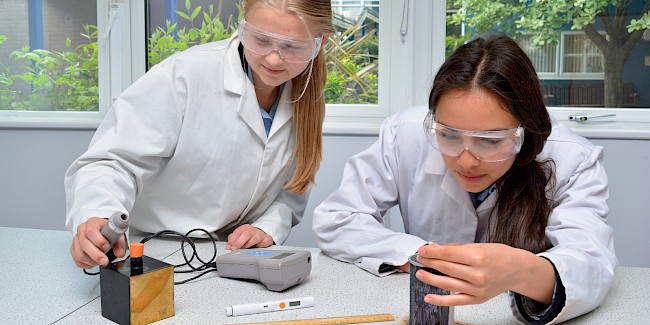Key Stage 5 Physics
Curriculum Overview
| | Term 1 | Term 2 | Term 3 | Term 4 | Term 5 | Term 6 |
|---|
| Year 12 | Energy production Waves | Thermal physics Atomic, nuclear and particle physics | Electricity and magnetism HL: Wave phenomena | Electricity and magnetism
Option topic (TBC) | Mechanics
Option topic completion | Mechanics
HL: Electromagnetic Induction |
| Year 13 | Mechanics Circular motion and gravitation | Circular motion and gravitation HL: Quantum and nuclear physics | Mocks and Revision | Revision | | |
Year 12
Physics is the most fundamental of the experimental sciences in the International Baccalaureate, as it seeks to explain the universe itself from the very smallest particles to the vast distances between galaxies. In year 12, students build upon previous knowledge to look at more complex problems such as objects in circular motion, field forces and wave theory. Models are developed to try to understand observations, and these themselves can become theories that attempt to explain the observations.
Through studying the topics outlined above, Physics students should become aware of how scientists work and communicate with each other. In addition, through the overarching theme of the “Nature of Science” this knowledge and skills will be put into the context of the way science and scientists work in the 21st century and the ethical debates and limitations of creative scientific endeavour.
Year 13
Students explore the lifecycle of the stars in detail, along with the role of gravity in the universe, including theories on how the universe was created and how it will end. They learn how to calculate the size of electromagnetic forces and use laws to predict their directions. Students go on to look at global energy use, making detailed calculations and evaluating alternatives to fossil fuels. Students enjoy looking at fundamental particles and interactions and touching on some basic Quantum theory.
Students are taught practically, with opportunities to design investigations, collect data, develop manipulative skills, analyse results, collaborate with peers and evaluate and communicate their findings. Students develop the skills to work independently on their own design, but also collegiately, including collaboration with schools in different regions, to mirror the way in which scientific research is conducted in the wider community.
Assessment
Throughout the course, students receive informal assessment via a mixture of verbal and written feedback, and using self and peer assessment. Students also experience formal mock examinations to familiarise with the examination protocol. Practice practical work is carried out in preparation for the Internally assessed investigation.
Formal assessment at the end of year 13 consists of the following HL papers:
| | Length of examination | Weighting |
|---|
| Paper 1 Multiple choice | 1 hour | 20% |
| Paper 2 Short answer and extended response | 2 hours 15 mins | 36% |
| Paper 3 Measurement and uncertainties and option topic | 1 hour 15 mins | 20% |
| Internal assessment | 10 hours lab + write up time | 24% |
Further Reading/Resources
Books:
- A Brief History of Time- Stephen Hawking
- Universe in a Nutshell- Stephen Hawking
- Three Roads to Quantum Gravity- Lee Smolin
Websites:
British Values:
British Values in Physics
Rule of law: Ethics of nuclear power/medicine and global warming. Practical rules for safe practice.
Mutual respect: Peer review, applying the scientific method.
Tolerance of others’ faith and beliefs: Big bang theory



